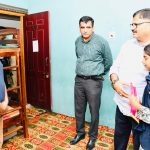The powerful earthquake measuring 7.8 on the Richter scale which shook Turkey and Syria on Monday once again brought to light the importance of a proper disaster management mechanism during natural calamities. As per media reports more than 11000 people have lost their lives so far and tens of thousands have got injured. Many experts are of the opinion that the death toll is likely to go up. Though it is not possible to avert all the natural disasters, there is a scope for minimizing the damage. Earthquakes are among the worst natural disasters that may strike for few seconds or minutes but cause enormous destruction to life and property. Around 5 lakh earthquakes occur every year, most of which are weak and not perceptible. Measured on the Richter Scale, earthquakes up to 5 magnitude are not detected by the people, while as above 5 can be felt. Earthquakes are felt every year in the world and many cause damage, sometimes serious and widespread. Volcanic activity being ruled out over plate tectonic and fault lines as causing major earthquakes, it is irremissibly to ignore warnings and be unprepared. All regions that fall under seismic zones and where there is constant strain on the surface, earthquakes are bound to happen. If the regions are inhabited by people, it becomes the responsibility of the state, government or other institutions to be alert and take measures beforehand to prevent loss of lives and damage to property. In Jammu and Kashmir several earthquakes have been felt lately. It is a fact that Jammu and Kashmir lies in seismic zone V-IV that has made people panicky in the past. There are two important considerations that the people and the government must apply to. The first is regarding saving lives in the few minutes of an earthquake striking. Safety measures advocated include: to move away from windows, glass doors, to take shelter under furniture like a bed so as to escape being injured by objects falling from ceiling, to douse any fire caused quickly, or if possible to move away from the house or building into an open area. Most importantly to remain calm. That is the safety drill for an earthquake which in many seismic regions is taught at school level. Children are made to learn to move to safety, seek cover or come out of the compounds as quickly and calmly as possible. This is also the safety drill that people in J&K must adopt to minimize the risks posed by earthquakes. The second consideration is regarding safety measures to be adopted as approved building norms. Earthquake above 7 magnitude are dangerous in the sense that they can topple houses and buildings. This is where government intervention is required. There has to be approval of all commercial and public buildings based on the finding of an expert team which can verify as whether these buildings can withstand a quake of 7-8 magnitude on the Richter Scale. The most deadly earthquake ever reported has been a little above 9. If the building norms are set to withstand that there is no need to worry too much. While safety drills are to be carried out by the people, ensuring earthquake safe buildings and constructions is the job of the administration.








